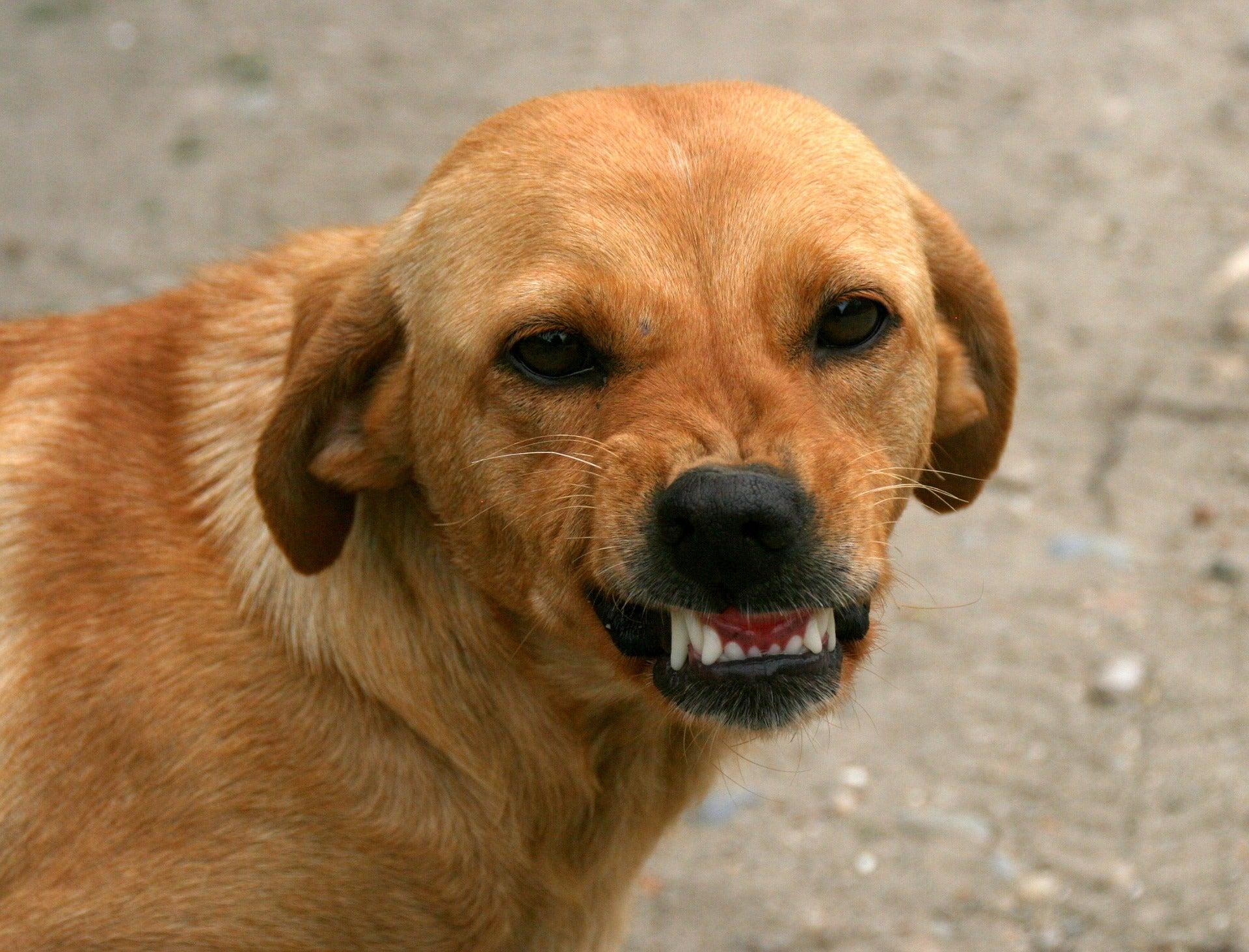Listen to this blog instead
Every dog has a different personality with their own unique quirks. Some are soppy or calm and others can be shy or aggressive. Either way, knowing your dog’s personality traits is key when you’re their puppy parent.
Having a dog that is showing signs of aggression can be worrying and stressful at times, particularly if you’re not sure what is causing these outbursts. There are many reasons your pup may be displaying signs of aggressive behavior, sometimes aimed at other dogs, humans or other triggers; loud noises, anxiety or foreign objects.
Trying to keep dog aggression to a minimum and knowing how to calm a dog down can be difficult at times, particularly when the trigger is something you can’t control. And, unfortunately, there isn’t one reason your pup may be acting aggressively… But, let’s learn how to calm an aggressive dog.
The Different Types Of Aggression In Dogs
The cause of this negative, aggressive behavior may be due to the following;
Frustration
Frustration aggression can manifest whenever a dog is restrained, like being on a leash or placed in a cage.
Social aggression
One possible explanation behind this is that the dog wasn’t exposed to other dogs as a pup, thus seeing them as threats.
Learned aggression
This is aggression that is reinforced either through training or positive reinforcement.
Fear aggression
Fear aggression is similar to flight or fight response and is a form of self-defense for dogs.
Protective/territorial aggression
Dogs will display aggressive behavior when another dog or creature breaches their territory or family.
Pain-elicited aggression
Dogs that are injured tend to lash out when they are approached to ward off potential threats.
Predatory aggression
This is usually prevalent among dogs with strong hunting instincts.
Hormone-based aggression
This is aggressive behavior that manifests when dogs are around other dogs they perceive as competition for a mate.
Take a look below at how to calm an aggressive dog. There are many different ways you can help reduce aggressive behavior in your pup. Some of these may take some time and patience, so it is wise to seek extra support from a vet or ethical, reputable professional dog behaviorist, if you find that your pup is making little progress.
How To Calm A Dog Down

Identify the signs
Aside from growling and barking, there are other signs of aggression to look out for, such as:
- Pricked ears
- Raised hackles
- Posturing
- Direct eye contact towards the cause of aggression
- Lunging
Once you identify these signs of aggression, you may elect to distract your dog or simply lead him away from the tense situation. Spotting the signs of aggression can also help you figure out your dog’s trigger. Whenever your dog gets aggressive, try to recall the situation as best as you can to pinpoint what made your dog become that way.
Aggressive dog behavior can also indicate a fearful dog or a dog experiencing bad memories. In this case, it’s imperative to identify their triggers and begin modifying their behavior. Additionally, if your pet’s trigger is unavoidable, try slowly exposing them to the trigger over time to get them more comfortable with the situation. For example, if your dog’s fear is thunder, you can play an audio clip of thunder but start at a low volume. Reward your canine with treats whenever they manages to remain calm while hearing the thunder. Do this repeatedly while gradually increasing the volume so your dog finally gets used to the sound of thunder.
Exercise
Just like us humans, your pup can have a lot of energy and tension built up inside them and without a way of expressing these, it could result in aggressive behavior due to this inability to release the energy. Most humans find that exercise releases positive hormones, the same usually applies to our fluffy friends. [1]
So, if you’re looking to learn how to calm an aggressive dog, make sure to take your pooch for regular walks; once or twice a day – the more energy they burn, the better their state of mind and emotions will be. If they’re lacking energy, they will find it difficult to become aggressive and irritable.
If you’re unsure how much exercise on average your dog and their breed needs per day, check out our handy PetLab Co guide or consult with your vet.

Socialize them
Ideally more beneficial when your dog was a puppy, introducing them to other dogs could seriously help the way they react when meeting a new dog… Or human, for that matter. Creating regular encounters with different new people or dogs is extremely beneficial. Dogs are pack animals naturally, which means they are incredibly sociable. When deprived of this innate behavior, it can cause issues such as aggression or vulnerability towards other dogs.
If you notice your pup becomes tense and angry around other dogs, the best thing to do would be to slowly introduce them to other pups. A simple walk around the park with other dogs should do the trick.
PetLab Co. Pro Tip: A great way to get your pup to socialize is to take them to a training class. That way they will be surrounded by other dogs on a regular basis.
Use high quality supplements
Rewarding good behavior is extremely important when trying to teach your pup new skills and lessons. The more you praise the good the more likely they’re to continue to want to act in a certain way – a very simple and easy idea. When the cause of aggression is due to your pet’s inability to manage normal stress, it can be hard to find ways of keeping your pup relaxed. So, when attempting to manage and learn how to calm a dog down, you could look to targeted calming chews for dogs. Some supplements are tailored to help calm nerves and reduce normal stress when your dog needs it most. The happier your dog feels, the less likely they are to become aggressive.
Attend behavioral classes

The cause of bad behavior is difficult to learn and sometimes can take years to find out what triggers your pup’s aggression. If you have adopted or rescued your dog, it may be the case of post-trauma that is causing the change from calm to anger. Taking your pup to a few behavioral classes could be the answer.
A class or a training camp will help you learn how to support your dog correctly and will also benefit your pup by learning around other dogs – socializing them as mentioned above. The tools that both yourself and your pup will learn will create the foundations for better behavior in the long run. How fast your pup learns the lessons depends on several factors, one of which is breed. Some dog breeds are more prone to aggressive behavior than most, such as the American Pit Bull terrier and Doberman Pinscher. If you’re interested in learning more about the most trainable dog breeds, we’ve written about this topic in detail.
If the aggression is much more severe, you might also consider consulting with an animal behaviorist. An animal behaviorist is an expert in behavior modification and can help identify triggers in any behavioral problem. Simply put, you get a customized treatment with this professional.
Try the muzzle

You may think a muzzle is cruel and restricting, but sometimes it is the best option for you, your pup, and others around you – humans and other animals. It may take some time for your canine companion to get used to the rubber cage around their mouths, but they will eventually find it normal. Combined with a harness, you will have more control over your pup if they begin to show aggressive patterns; barking, snarling, or jumping.
PetLab Co. Pro Tip: Practice makes perfect! Pop the muzzle and harness – better than a leash as you will have more control over their body – on your pup for 15 mins each day. This will help reduce any stress the change may cause which could result in more negative behavior.
Stay calm
It is incredibly important that you, as their puppy parent, keep calm when they’re showing signs of aggression or distress. When you begin to tense or show stress, your dog will sense these negative emotions and may end up causing them to react more. You may or may not realize, but your dog will rely on you and your body language when dealing with a new, different environment. [2]
Instead, be a calm and gentle leader for your dog. If your pup shows aggression to other dogs when you’re taking them out for a walk, try to keep yourself calm and centered. The calmer you are, the less likely your pup will start to become tense and distressed. If you’re expectant of this behavior, you may find that you begin to worry and tense when another unfamiliar dog approaches, which will only exacerbate the situation.
Neuter or Spay
Certain hormones trigger a dog’s behavior. Dogs who haven’t been neutered or spayed display aggression towards other dogs they view as competition for a mate. Spaying or neutering them at the right age prevents these hormonal behaviors from developing. But, if they are spayed or neutered much later, not only would those aggressions and behaviors linger, they might be more difficult to wean off.
How To Calm Down A Puppy
If you’re after a calm puppy, this all comes down to training if they’re particularly hyper or nipping. As well as making sure they’re being stimulated with exercise and socializing, getting on top of their training and keeping them in a routine will help calm your pup enormously. Read our blog with our beginner tips to training your dog here!
Final thoughts on how to calm dogs down
It is very easy to worry and become stressed when you’re living with an aggressive dog – their anxieties and behavior can, in turn, cause you to feel anxious and scared. Dogs are very powerful and when acting out of aggression can be rather threatening and concerning. The key? Try to stay dominant and calm! Remaining level-headed is crucial to dog training because your dog will also react to your emotions, so the stronger and more relaxed you are, the easier it will be to keep them from turning the aggression onto you. If you follow these simple steps, you will notice some real changes in your pup’s reactions to different triggers.
Sources
“Can I Calm My Dog down by Having Him Neutered? – News.” Hillcrest Animal Hospital, Chorley, https://www.hillcrestanimalhospital.co.uk/news/2017/can-i-calm-my-dog-down-by-having-him-neutered
“How to Tell If a Dog Is Being Aggressive.” Sit Means Sit Dog Training Austin, 16 Oct. 2019, https://sitmeanssit.com/dog-training-mu/austin-dog-training/how-to-tell-if-a-dog-is-being-aggressive/
Flowers, Amy. “Could My Dog Have PTSD?” WebMD, WebMD, 7 May 2021, https://pets.webmd.com/dogs-emotional-problems#1
“Dog to Dog Aggression – Why & How To Stop It” Shiba Shake, https://shibashake.com/dog/dog-to-dog-aggression








